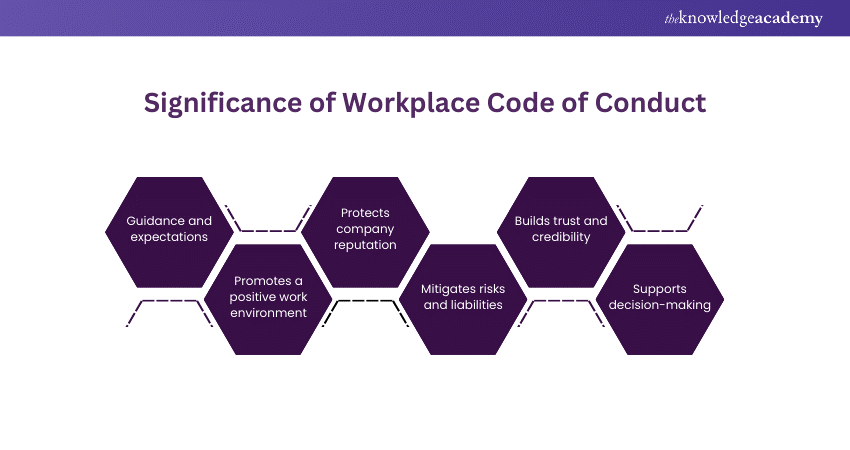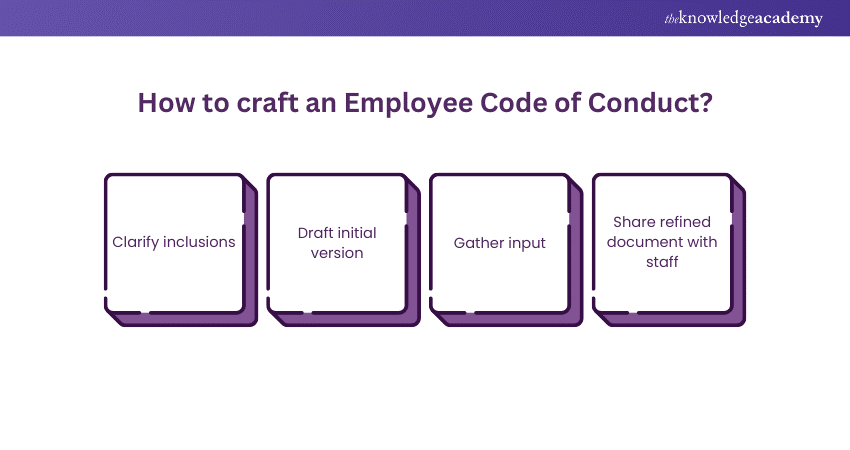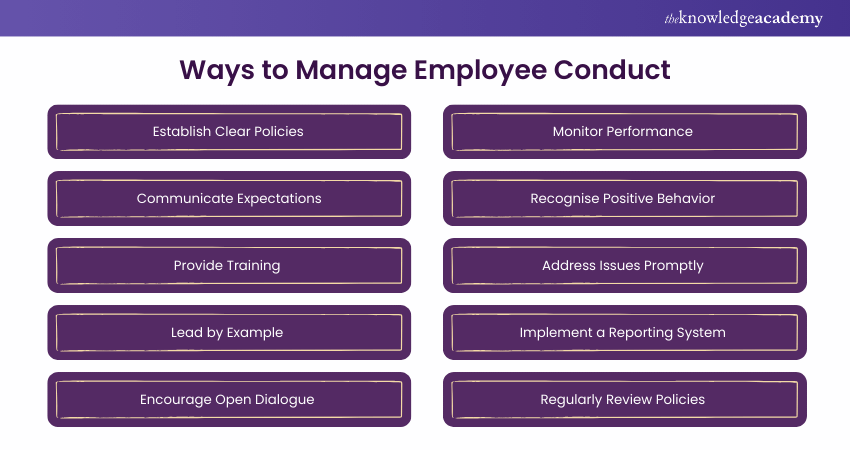We may not have the course you’re looking for. If you enquire or give us a call on 01344203999 and speak to our training experts, we may still be able to help with your training requirements.
Training Outcomes Within Your Budget!
We ensure quality, budget-alignment, and timely delivery by our expert instructors.
- CMI Level 5 Diploma in Management and Leadership Training Course
- CMI Level 5 Award in Managing Equality, Diversity and Inclusion Training Course
- CMI Level 5 Award in Principles of Professional Coaching Training Course
- CMI Level 5 Award in Professional Coaching Practice Training Course
- CMI Level 5 Certificate in Police Management Training Course

Have you ever wondered What is Employee Code of Conduct? Similar to traffic laws that ensure road safety and smooth traffic flow, an Employee Code of Conduct serves as a guidebook for professional behaviour in the workplace. It serves as a guidebook for navigating professional interactions and responsibilities, promoting a harmonious and productive work environment.
If you are interested in learning more about the Employee Code of Conduct and how to craft one, then this blog is for you!
Table of Contents
1) What is an Employee Code of Conduct?
2) Who Writes the Employee Code of Conduct?
3) Significance of Workplace Code of Conduct
4) Crafting a Code of Conduct for Employee
5) How to Manage Employee Conduct?
6) Examples of Some Great Employee Code of Conduct
7) Conclusion
What is an Employee Code of Conduct?
An Employee Code of Conduct is a set of comprehensive guidelines and principles established by an organisation to govern the behaviour and actions of its employees. It outlines the expected standards of behaviour, ethical principles, and professional conduct that employees are required to adhere to while performing their duties.
The code typically covers areas such as integrity, honesty, respect for others, confidentiality, compliance with laws and regulations, and proper use of company resources. It serves as a framework for promoting a positive work culture, maintaining ethical standards, and ensuring consistency in behaviour across the organisation.
Who Writes the Employee Code of Conduct?
The Employee Code of Conduct is typically developed by the organisation's human resources department in collaboration with legal advisors and senior management. This ensures that the code aligns with the organisation's values, mission, and legal requirements while reflecting industry standards and best practices.
Depending on the organisation's size and structure, input may also be sought from various stakeholders, including employees, to ensure broad representation and acceptance of the code. Once finalised, the code is usually communicated to all employees and may require acknowledgement of understanding and agreement to comply.
Significance of Workplace Code of Conduct
The Workplace Code of Conduct is of significant importance to both employees and organisations. Here are some key reasons why:

1) Guidance and Expectations: The code provides clear guidelines on acceptable behaviour and sets expectations for how employees should conduct themselves in the workplace. This helps prevent misunderstandings and ensures consistency in behaviour across the organisation.
2) Promotes a Positive Work Environment: By promoting respect, professionalism, and integrity, the code fosters a positive and inclusive work culture. When everyone understands and abides by the same standards, it creates a harmonious and supportive atmosphere for all employees.
3) Protects Company Reputation: Upholding ethical standards and legal compliance outlined in the code helps to safeguard the organisation's reputation. It demonstrates to clients, stakeholders, and the public that the company values integrity and operates with transparency and accountability.
4) Mitigates Risks and Liabilities: A comprehensive Code of Conduct can help mitigate risks and liabilities by outlining appropriate conduct in areas such as harassment, discrimination, confidentiality, and conflicts of interest. This can reduce the likelihood of legal disputes and regulatory violations.
5) Builds Trust and Credibility: When employees observe that the organisation takes its Code of Conduct seriously and enforces it consistently, it builds trust and credibility both internally and externally. Employees feel confident in the organisation's commitment to fairness and integrity, while stakeholders view the company as a trustworthy partner.
6) Supports Decision-making: The code serves as a reference point for employees when faced with ethical dilemmas or difficult decisions. It offers a structure for ethical decision-making and empowers employees to make choices aligned with the organisation's values and principles.
Crafting a Code of Conduct for Employee
Crafting a Code of Conduct for employees involves several important steps to ensure it accurately reflects the values and expectations of the organisation. Here's how to do it:

Clarify Inclusions
Start by clearly defining what should be included in the Code of Conduct. This could involve reviewing existing policies, legal requirements, and industry standards. Identify key areas such as ethical behaviour, professional standards, workplace relationships, confidentiality, and compliance with laws and regulations. By clarifying what should be covered, you lay the foundation for a comprehensive and relevant document.
Learn how to enhance your mentoring skills with our Professional Mentoring Training – join now!
Draft Initial Version
With a clear understanding of what to include, begin drafting the initial version of the Code of Conduct. Use simple, easy-to-understand language that aligns with the organisation's tone and culture.
Clearly outline each section, providing specific guidelines and examples where necessary. Ensure that the document is structured logically and covers all essential aspects of employee behaviour and responsibilities.
Gather Input
Once the initial draft is prepared, seek input from relevant stakeholders, including employees, managers, HR professionals, and legal advisors. Promote open dialogue and feedback to ensure that diverse perspectives are considered.
Ask for suggestions on areas that may need clarification or improvement, as well as any additional topics that should be addressed. This collaborative approach helps to ensure buy-in and acceptance of the final document.
Share Refined Document With Staff
After incorporating feedback and making necessary revisions, share the refined version of the Code of Conduct with all staff members. Provide clear instructions on where to access the document and how to provide further feedback if needed.
Encourage employees to review the code carefully, ask queries, and obtain clarification on any features they find unclear. Reinforce the significance of adhering to the code and explain how it contributes to a positive work environment and the organisation's overall success.
How to Manage Employee Conduct?
Maintaining a positive workplace environment depends on effectively managing employee behaviour. Here are tips designed for remote and office employees:

1) Remote Workers
a) Set Clear Expectations: Establishing clear expectations involves clearly outlining guidelines for behaviour, communication, and collaboration.
b) Utilise Technology: Use tools to track performance and enable regular meetings to guarantee accountability.
c) Encourage Open Communication: Create surroundings where employees are at ease to talk about problems and difficulties.
d) Provide Training: Offer training and resources specifically designed for remote environments to teach professionalism and proper workplace behaviour.
2) Office Workers
a) Implement a Code of Conduct: Create and share a detailed Code of Conduct that specifies appropriate behaviours.
b) Lead by Example: Demonstrate the behaviour you want to see from your employees in order to establish a culture of responsibility.
c) Address Issues Promptly: Address any behavioural issues as soon as they occur to avoid them getting worse and keep a positive environment.
d) Recognise Positive Behavior: Commend and compensate workers who exhibit outstanding behaviour, upholding the expected criteria.
Examples of Some Great Employee Code of Conduct
Let's take a look at the Employee Code of Conduct for Coca-Cola and Google:
1) Coca-Cola
Coca-Cola's Employee Code of Conduct is known for its emphasis on integrity, diversity, and responsible business practices. Here are some highlights:
a) Integrity and Honesty: Coca-Cola emphasises honesty and integrity in all business dealings. Employees are expected to act with transparency and uphold high ethical standards.
b) Respect for Diversity: The company values diversity and inclusion, respecting people's differences in background, culture, and perspectives. Discrimination and harassment are strictly prohibited.
c) Community Engagement: Coca-Cola encourages employees to actively engage with their communities and contribute to social responsibility initiatives. This includes promoting environmental sustainability and supporting local communities.
d) Confidentiality and Data Privacy: Employees must uphold the confidentiality of sensitive information and adhere to data privacy laws. Protecting company and customer data is a top priority.
e) Compliance with Laws and Regulations: Coca-Cola places a strong emphasis on adhering to all relevant laws and regulations, whether they are domestic or international in nature. This includes laws related to competition, anti-corruption, and product safety.
Are you interested in learning more about management training? Then sign up now for our Management Coaching And Mentoring Course.
2) Google
Google's Employee Code of Conduct is renowned for its innovative approach to workplace culture and ethics. Here are some key aspects:
a) "Don't Be Evil" Philosophy: Google's famous mantra encourages employees to prioritise ethical decision-making and do what's suitable for users, customers, and society as a whole.
b) Respect for Diversity and Inclusion: Google promotes a culture of respect and inclusion, embracing diversity in all its forms. Employees are encouraged to fully express themselves at work and play a part in creating an inclusive and supportive atmosphere.
c) Focus on Innovation and Creativity: Google encourages employees to think outside the box, take risks, and pursue innovation. This freedom to experiment and explore new ideas fosters a culture of creativity and collaboration.
d) Responsibility Towards Users and Society: Google emphasises its responsibility to provide safe, reliable, and trustworthy products and services to users. This includes prioritising user privacy and security and combating misinformation and harmful content.
e) Environmental Stewardship: Google is committed to minimising its environmental impact and promoting sustainability. This involves initiatives aimed at lowering carbon emissions, preserving water and energy, and advocating for renewable energy alternatives.
Conclusion
We hope you read and understand What the Employee Code of Conduct is and how to craft one. It is crucial for guiding employees on expected behaviour and ethical practices within an organisation. It helps in creating a respectful, inclusive, and productive workplace environment. Setting clear standards and expectations supports employees in making ethical decisions, protects the company's reputation and minimises legal risks.
Are you interested in learning more about Leadership and Management Skills? Sign up for our Professional Consulting Training now!
Frequently Asked Questions

The ISO Code of Conduct refers to ethical and professional standards set by the International Organization for Standardization for its members and participants. These standards guide behaviour in areas such as respect, integrity, transparency, and compliance with laws and ISO's own rules and policies.

An ethical rule of conduct is a guideline or principle designed to direct behaviours morally and responsibly. These rules help individuals distinguish between right and wrong actions in various situations, ensuring fairness, integrity, and respect towards others.

The Knowledge Academy takes global learning to new heights, offering over 30,000 online courses across 490+ locations in 220 countries. This expansive reach ensures accessibility and convenience for learners worldwide.
Alongside our diverse Online Course Catalogue, encompassing 17 major categories, we go the extra mile by providing a plethora of free educational Online Resources like News updates, Blogs, videos, webinars, and interview questions. Tailoring learning experiences further, professionals can maximise value with customisable Course Bundles of TKA.

The Knowledge Academy’s Knowledge Pass, a prepaid voucher, adds another layer of flexibility, allowing course bookings over a 12-month period. Join us on a journey where education knows no bounds.

The Knowledge Academy offers various CMI Level 5 Training, including the CMI Level 5 Award In Management And Leadership Training, CMI Level 5 Diploma In Management And Leadership Training Course, and CMI Level 5 Certificate In Management And Leadership Training Course. These courses cater to different skill levels, providing comprehensive insights into Is ILM Level 5 Worth it.
Our ILM, CMI Leadership & Management Blogs cover a range of topics related to CMI, offering valuable resources, best practices, and industry insights. Whether you are a beginner or looking to advance your Leadership skills, The Knowledge Academy's diverse courses and informative blogs have got you covered.
Upcoming ILM, CMI Leadership & Management Resources Batches & Dates
Date
 CMI Level 5 Award in Management and Leadership Training
CMI Level 5 Award in Management and Leadership Training
Fri 28th Feb 2025
Fri 4th Apr 2025
Fri 27th Jun 2025
Fri 29th Aug 2025
Fri 24th Oct 2025
Fri 5th Dec 2025







 Top Rated Course
Top Rated Course



 If you wish to make any changes to your course, please
If you wish to make any changes to your course, please


